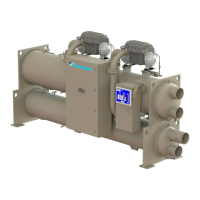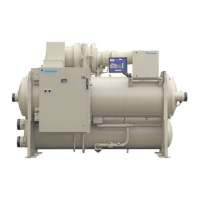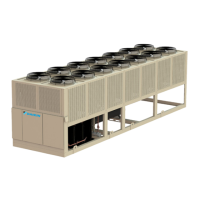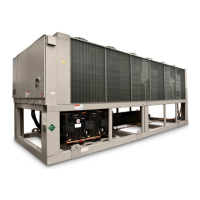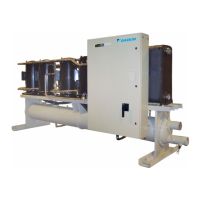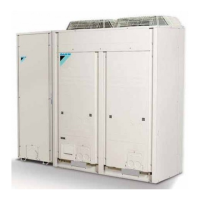INSTALLATION
NAVIGATOR WWV/TWVDAIKIN APPLIED
10
Figure 5: Drain Plug Installation
No. Description
1 Plug
2 Vent Hole (Air Purge)
3 Drain Hole (Under Insulation)
Flow Switch
A ow switch must be included in the chilled water system
to prove that there is adequate water ow to the evaporator
before the unit can start or to shut down the unit if water ow is
interrupted. A solid state, thermal dispersion ow switch that is
factory-wired is standard and is mounted in the chiller leaving
water nozzle.
Figure 6: Flow Switch
Temperature sensors and pressure gages are recommended
on the water pipes near the heat exchangers connections.
Furthermore, air vents must also be installed at the highest points
on the pipe.
Should water pump noise be excessive, we recommend using
exible connectors at both pump or chiller inlet and outlet.
Variable Speed Pumping
Reducing evaporator ow in proportion to load can reduce
system power consumption. Daikin Applied chillers are designed
for variable water ow duty provided that the rate of change
is less than 10 percent of the design ow per minute, and the
minimum and maximum ow rates for the evaporator are not
exceeded. If ow drops below the minimum allowable, large
reductions in heat transfer can occur. If the ow exceeds the
maximum rate, excessive pressure drop and tube erosion can
occur. For example, if the maximum design ow is 200 gpm and
it will be reduced to a ow of 140 gpm, the change in ow is 60
gpm. Ten percent of 200 gpm equals 20 gpm change per minute,
or a minimum of three minutes to go from maximum to desired
ow.
Glycol Solutions
Test coolant with a clean, accurate glycol solution hydrometer
or refractometer to determine the freezing point. On glycol
applications, the supplier normally recommends that a minimum
of 25% solution by weight be used for protection against
corrosion or that additional inhibitors should be employed.
The use of glycol may impact system performance depending on
its concentration and should be considered during initial system
design.
CAUTION
Do not use automotive grade antifreeze. Industrial grade glycols
must be used. Automotive antifreeze contains inhibitors that will
cause plating on the copper tubes within the chiller evaporator.
The type and handling of glycol used must be consistent with
local codes.
Ice Mode
Ice making chillers will run very cold uid during o hours,
when energy is least expensive, to build a tank of ice. In ice
building mode, the unit will operate at full load until the shuto
temperature setpoint is reached. Optional double evaporator
insulation is recommended for ice mode operation. The standard
controller software will require “ice” setpoint changes and a
digital signal into the controller is required to change to the ice
mode and back to standard cooling. Set points related to ice
mode can be found in “Unit Level Set Points” on page 27 and
wiring connection points are shown in Figure 16.
Condenser Water Control
The minimum condenser inlet water temperature should not
be less than 60°F (15.6°C). If the water temperature is lower, a
method of condenser water temperature control will be required.
Cooling tower control is discussed beginning on page 34.
Two-Way Bypass Valve Operation
A two-way regulating control valve can control ow to ensure
adequate condenser water temperature. The unit controller can
send a 0-10Vdc signal to the valve to modulate its position.
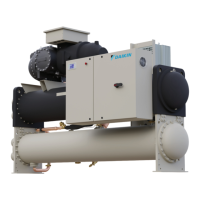
